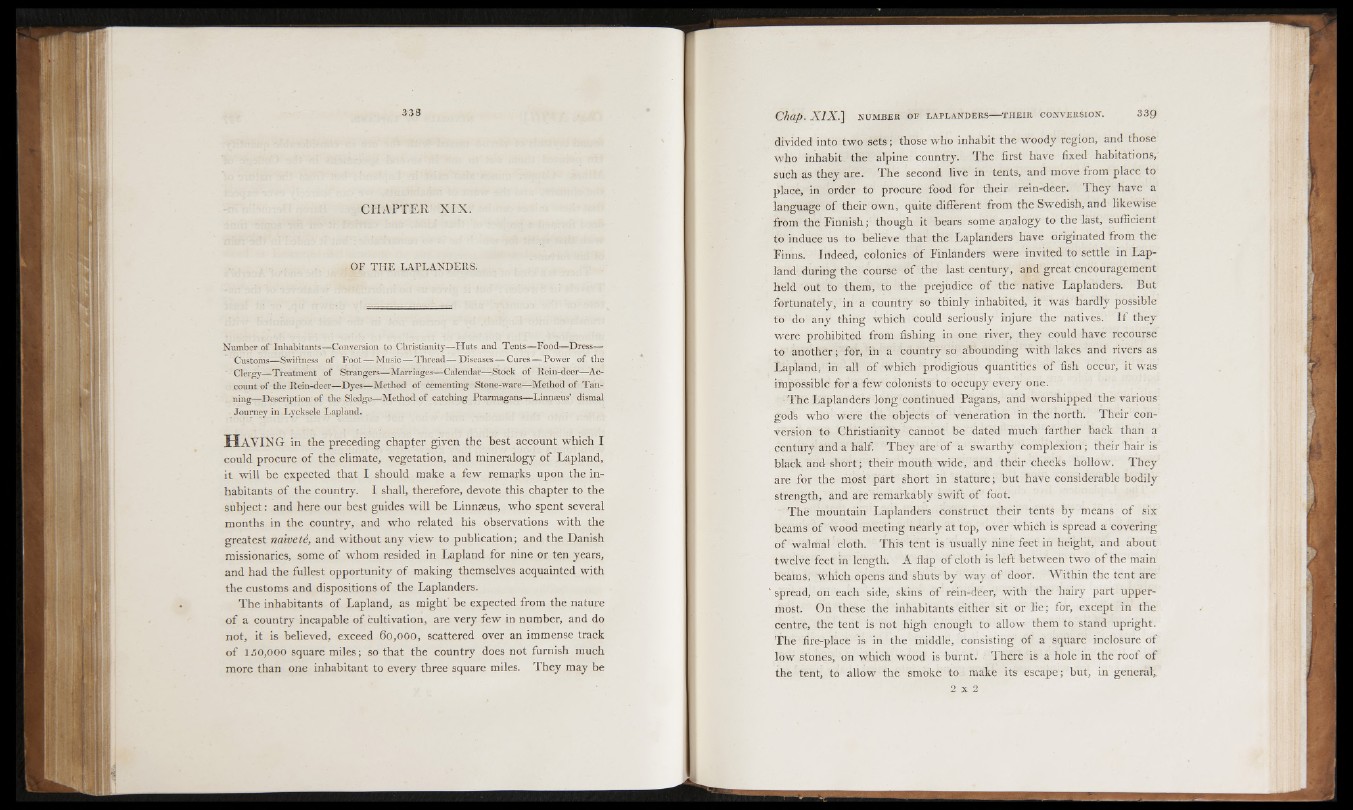
CHAPTE R X I X .
OF THE LAPLANDERS.
Number of Inhabitants—Conversion to Christianity—Huts and Tents—Food—Dress—■
Customs—Swiftness of Foot — Music—Thread—Diseases—Cures—Power of the
Clergy—Treatment of Strangers—Marriages—Calendar—-Stock of Rein-deer—Account
of the Rein-deer—Dyes—Method of cementiiig Stone-ware—Method of Tanning—
Description of the Sledge—Method of catching Ptarmagans—Linnaeus’ dismal
Journey in Lycksele Lapland.
H a v i n g in the preceding chapter given the best account which I
could procure of the climate, vegetation, and mineralogy of Lapland,
it will be expected that I should make a few remarks upon the inhabitants
of the country. I shall, therefore, devote this chapter to the
subject : and here our best guides will be Linnæus, who spent several
months in the country, and who related his observations with the
greatest naïveté, and without any view to publication; and the Danish
missionaries, some of whom resided in Lapland for nine or ten years,
and had the fullest opportunity o f making themselves acquainted with
the customs and dispositions of the Laplanders.
The inhabitants of Lapland, as might' be expected from the nature
o f a country incapable of cultivation, are very few in number, and do
not, it is believed, exceed 60,000, scattered over an immense track
of 150,000 square miles; so that the country does not furnish much
more than one inhabitant to every three square miles. They may be
divided into two sets; those who inhabit the woody region, and those
who inhabit the alpine country. The first have fixed habitations,
such as they are. The second live in tents, and move from place to
place, in order to procure food for their rein-deer. They have a
language of their own, quite different from the Swedish, and likewise
from the Finnish; though it bears some analogy to the last, sufficient
to induce us to believe that the Laplanders have originated from the
Finns. Indeed, colonies of Finlanders were invited to settle in Lapland
during the course of the last century, and great encouragement
held out to them, to the prejudice of the native Laplanders. But
fortunately, in a country so thinly inhabited, it was hardly possible
to do any thing which could seriously injure the natives.1 I f they
were prohibited from fishing in one river, they could have recourse
to another; for, in a country so abounding with lakes and rivers as
Lapland, in all of which prodigious quantities of fish occur, it was
impossible for a few colonists to occupy every one.
The Laplanders long continued Pagans, and worshipped the various
godk who were the objects of veneration in the north. Their conversion
to Christianity cannot be dated much farther back than a
century and a half. They are1 of a swarthy complexion ; their hair is
black and short; their mouth wide, and their cheeks hollow. They
are for the most part short in stature; but have considerable bodily
strength, and are remarkably swift of foot.
The mountain Laplanders construct their tents by means o f six
beams of wood meeting nearly at top, over which is spread a covering
o f walmal cloth. This tent is usually nine feet in height, and about
twelve feet in length. A flap of cloth is left between two o f the main
beams, which opens and shuts by way of door. Within the tent are
spread, on each side, skins of rein-deer, with the hairy part uppermost.
On these the inhabitants either sit or lie; for, except in the
centre, the tent is not high enough to allow them to stand upright.
The fire-place is in the middle, consisting of a square inclosure of
low stones, on which wood is burnt. There is a hole in the roof of
the tent, to allow the smoke to make its escape; but, in general,.
2 x 2